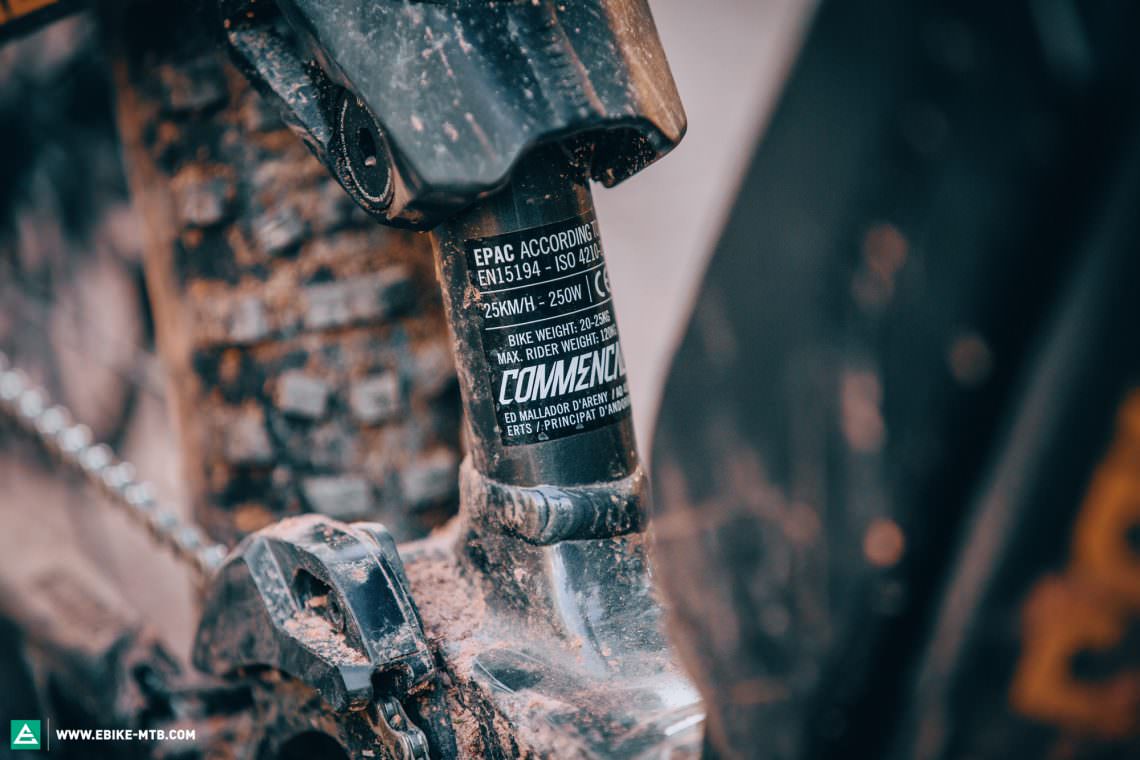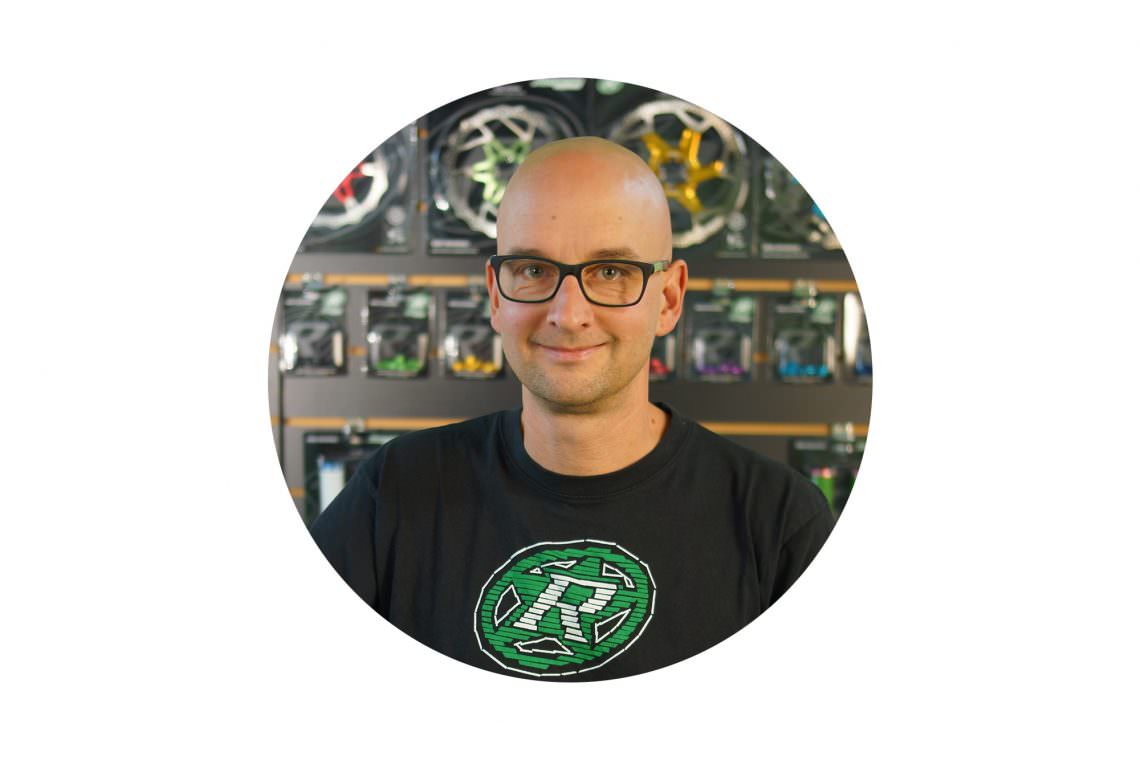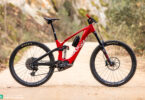Did you know that if your bike is rated for 120 kg total weight, you yourself can’t really weigh much more than 90 kg? There’s increasing discussion concerning the ratings and approved loads for bikes which raises a lot of unanswered questions. We tried to get to the bottom of things, quizzing bike manufacturers, experts and testing laboratories to shed some light into the darkness.

1. What does the total weight limit mean for me?
The total weight limit for an eMTB factors in the following components:
- Weight of the rider (including shoes, clothing, helmet and other kit)
- Weight of the bike (including accessories such as bottles)
- Weight of your rucksack or any other luggage
The total weight limit of the bike is also sometime known as the maximum permissible weight limit. That’s different to the load limit, which refers to the total of rider weight limit and cargo weight limit. This may be called different things by manufacturers, for example, Specialized refers to this as the Structural Weight Limit.
Legally, the total weight limit for any bike must be at least 120 kg. All the eMTBs that we have tested so far this year have a rating of between 115 kg and 156 kg. Initially, that might seem like a lot, but subtract 20 kg to 25 kg for the weight of the bike and you’re often left with just 100 kg to play with for rider, clothing, equipment and other cargo.
Example calculation for a bike with a 120 kg rating:
120 kg
-23 kg bike
-4 kg rucksack
-2 kg clothes, helmet and shoes
= 91 kg maximum rider weight

2. Why has the total weight limit only recently become such an important topic?
The bicycle has a documented history that dates back more than 200 years. eMTBs only entered the market less than 10 years ago, and have developed rapidly since then. You can now ride trails on your eMTB, both up- and downhill, that were previously the exclusive territory of enduro bikes. Whereas the first eMTBs were equipped with standard mountain bike components, more and more “E-Bike optimised” components designed to withstand the additional rigours faced by an eMTB, are finding their way onto current models. Be wary though: some components are furnished with “E-Bike labels” purely for marketing reasons, unlike those that have actually been designed and tested specifically for their purpose.
The fact is that eMTBing not only creates unique challenges for the designers and engineers creating the bikes, but also for traditional testing norms and standards which ensure the safety of your bike. The motor assistance results in higher loads on components, just as the increased torque and weight also take their toll. The increased riding enjoyment can also lead to increased use and longer rides. That all adds up to components being subjected to more kilometres riding, more metres ascending, more weight and more torque, leading to significantly larger amounts of wear and tear and reduced durability.
That also means that warranty claims for defective components can be more difficult to claim successfully, particularly if the rated weight limit for the bike has been exceeded!
3. Glossary: the most important terms explained
Product Safety Act Most countries have a product safety act that is independent of standard norms and requires manufacturers to guarantee the safety of their bikes during use through independent testing. For E-Bike manufacturers, that means exceeding the standards set out in ISO 4210 and EN 15194. According to the German Product Safety Act (Produktsicherheitsgesetz), the manufacturer also has to remain up to date with current technologies and production methods, as simply conforming to standards does not clear them of indemnity.
Intended use – ASTM standards and ASTM conditions
Warranty terms generally mention “intended use” as part of their stipulations. This excludes warranty claims if the bike is deemed to have been used outside the kind of riding it was designed or intended for.
Manufacturers generally specify five categories (from Asphalt to Gravity), though the detailed specification can vary between them. For example, where one manufacturer may specify jumps of up to 0.30 m in Condition 3, another may extend that up to 0.60 m. For this example, those same manufacturers allow eMTBs falling under Condition 4 (intended for all-mountain use), to take on jumps of 1.00m or 1.20 m respectively.
The categories are defined in the ASTM standards, which also state the maximum load (rider and cargo) or maximum system weight.
Trailer or child seat use
Reading the manual for your eMTB should reveal whether the manufacturer allows it to be used with a bike trailer or child seat. The weight of the trailer and its occupant makes up part of the system weight. You should also be aware that a Condition 4 eMTB is classed as a Condition 2 bike once a trailer is attached, meaning it can’t be used on rough terrain or in the bike park with one fitted.
Machinery directive 2006/42/EC
eMTBs and pedelecs are both encompassed by the EU Machinery Directive, meaning the manufacturer must show adherence to the EC (European Council) conformity declaration. This involves a legally binding document provided to the purchaser, in which the manufacturer confirms adherence to these norms. The CE sign printed on the bike frame is also an indication for this.
CE mark The CE symbol is a self-certified mark which indicates that the manufacturer claims conformity to the EU harmonised standards that govern and regulate the product.
4. Which standards do eMTBs have to conform to?
In order to understand the requirements demanded of eMTBs and the maximum total weight limit, it’s important to understand the standards which apply to them. There are two relevant standards here, namely ISO 4210 and EN 15194. Pretty much all frames and components worldwide are designed, tested and approved according to these standards.
ISO 4210
ISO 4210 for bicycles (which is applicable both in Europe and internationally) defines industry standard tests and testing procedures. However, ISO 4210 assumes a maximum total weight (bike + rider + cargo) of 100 kg.
EN 15194
The European EN 15194 is intended specifically for eBikes and sits alongside ISO 4210. EN 15194 is applicable to EPAC (Electric Power Assisted Cycles) which are fitted with both pedals and an electric motor and can be used on public roads. EN 15194 also describes standardised tests and procedures, though with higher loads and a maximum total weight of 120 kg. However, this standard was written with road and touring bikes in mind and is intended to ensure that eBike components meet minimum requirements and work together as a complete system.
That means that there are no real standards or standardised tests that apply specifically to eMTBs. The procedures laid out in EN 15194 don’t really reflect the loads encountered by eMTBs during real-world use, creating something of a grey area with uncertainty and a lack of transparency regarding E-Bike approval. As a result, manufacturers have been forced to conduct their own tests in order to have the confidence to rate their eMTBs for higher loads. Moreover, manufacturers are obliged to observe their target market and rate their bikes according to loads that are applicable to its intended use. It’s not enough to certify a bike for a certain intended use. Instead the bike must be tested according to criteria that reflect how a “normal user” would ride it.
For all the larger European eBike manufacturers, this means that along with the Product Manager and Head of Development, the CE commissioner also plays an important role in the development of an eMTB. For example, for Marco Wolff-Staudacher, the CE commissioner for MERIDA, an “E-Bike optimised” label or weight limit of 150 kg is a good indicator, but isn’t enough for him to give the go-ahead to use a component on their production bikes. Instead the components must pass either in-house or external testing. In the end, the CE commissioner has final say when it comes to the specification of the bike. That’s crucial because the manufacturer always remains legally responsible for the bike and in turn the components fitted to it. We regard the practice of some manufacturers to try and push responsibility for the total weight limit onto component suppliers, by simply relying on their recommendations, as somewhat irresponsible – especially for themselves.

What do bike and component manufacturers say about the maximum total weight limit
We haven’t just examined the legal definitions and standards, but have also talked with manufacturers to get their take on the rating and weight limits for eMTBs. We received responses with different approaches and views, as well as different legal interpretations. We’ve left the manufacturers’ statement as we received them for you to look through.

Head of Engineering | Haibike
“Unfortunately, the tests defined by the ISO standards lag behind what’s going on in the real world, particularly for e-Bikes, which is why for the last 2 years at Haibike, we have been developing our own tests together with a respected testing lab, which in the future will check bikes and components for a total permissible weight of 150 kg for all five [ASTM] categories. Frames and components will be tested more and more according to these in-house tests in addition to the standard ones. Even though our test clearly exceeds the ISO qualification, the ISO test will remain part of our procedure, as this provides the legal basis for allowing products to be sold on the market.
Important: to rate a bike for a higher weight limit, it’s not enough just to test the frame! All safety-critical parts (frame, fork, brakes, wheels, bars, stem, seat post, saddle, cranks, pedals) must undergo and pass tests at this higher load. It only takes one component to fail for the bike not to be approved.
Defining a new test is a long and extensive process and starts with having to develop new testing equipment and test procedures. We’ve managed to get several suppliers for frames, parts and drive components on board, but not all of them. It’s particularly those suppliers that don’t make special parts specifically for us (e.g. forks, brakes and wheels) who drag their feet in implementing these special tests, as they’re not official ISO designations. More often than not they ask “Why should we do this and invest all this money if it’s not a legal requirement?”… Luckily, there seems to be a rethinking of this approach at the moment.
As regards “intended use” and assigning ASTM categories to bikes: it makes a big difference if you’re trying to certify a trekking bike (ASTM Condition 1) or, for example, a Haibike XDURO Nduro (ASTM Condition 5), for a higher rated total weight. The loading cycles and maximum forces are very different and, as an example, there are currently no bars on the market that can be classed for ASTM Condition 5 use for a rated load of 150 kg, according to our testing procedure. There’s still a lot of development work to be done here.
In the future we are planning to test, starting with the FLYON range, for a higher maximum total weight based on our test protocol. Incidentally, that’s another reason why our FLYON models are a little heavier than other e-Bikes. However, as may have become obvious, there’s still a lot of testing of individual components to be done and it will take a little time to put this into reality, as much as we would like it to be standard now.”

CE Commissioner | MERIDA Bikes
“All eMTBs manufactured by Merida are currently rated to a total weight of 140 kg. However, our e-Bikes must have a safety factor that exceeds this nominal rating. Of course, our goal is to increase the weight limit, though that requires extensive testing of both individual components and complete eMTBs. Merida test all the critical components that we don’t manufacture ourselves and also test them for anticipated misuse. Whilst increasing the weight rating for trekking and city ebikes to 150 kg will be easy to achieve for the next model year, that becomes a lot harder for the higher loads experienced by eMTBs. Now, test labs can even simulate eMTB use in the bikepark.”

Marketing Specialist/Public Relations | DT Swiss AG
“At DT Swiss we responded to dedicated eMTBs two-years ago, with the introduction of DT Swiss HYBRID wheels. At DT Swiss we take our cue from the “state-of-the-art” and exceed the required standards. For example, the HYBRID hubs are based on the legendary 240 DT hubs, but have been designed specifically for the higher loads experienced by an E-MTB. The hub body has larger wall thicknesses, a larger housing, reinforced axle and larger spoke holes. Larger bearings, a new ratchet system with 24-teeth and a steel freehub body complete the package. That allows the HYBRID hubs to withstand up to 500 Nm torque, 25% more than our standard hubs.
With the only exception being our carbon rims, tailoring our wheels to the intended use has allowed us to increase the rating for DT Swiss HYBRID wheels from 120 kg to 150 kg. Incidentally, our DT Swiss F535 ONE fork is also rated to 150 kg.”

Marketing Manager | FOX
“To withstand the higher demands placed on suspension forks by eMTBs, we developed an eBike specific chassis, furnished with all the technologies you’ll know from our standard mountain bike forks. We have increased the wall thicknesses of the steerer and stanchions and fitted a solid crown for the eBike specific forks. Obviously, we’ve also tuned the damping to suit eMTBs. The eBike specific chassis is available for 34- and 36-series forks and is available in our Rhythm, Performance, Performance Elite and Factory models. Our current eBike chassis is rated for a maximum total weight of 169 kg.”

Sales Manager | Reverse Components
“At Reverse Components we have developed a special E-Series of components specifically for eMTBs, which are extensively tested at the EFBE test lab. As the European EN 15194 standard isn’t sufficient for the increased loads experienced by eMTBs, the lab had to develop a new standard for testing our E-Bike components.
An E-Series bar can be rated to different loads depending on its intended use. Whilst our bars are rated to 130 kg for Condition 5 use (challenging, very rough and extremely steep terrain with large jumps and high speeds), that increases to 160 kg if the use is limited to cross-country. That means that the rated weight limits also depends on the intended use definitions outlined in the ASTM standards. Thanks to our years of experience, all our stated weight limits are of course specified with sufficient safety margins.”

Marketing Manager | MAXXIS
“Every MAXXIS mountain bike tyre is rated for a load of 90 kg and as a result is also suitable for eBiking (with a 25 km/h assistance limit). However, the higher weight and increased torque of an eMTB can lead to more deformation in the tyre, leading to increased puncture susceptibility and a spongy feeling tyre. That’s why we recommend reinforced casings for E-MTB use.
In order to make a more a stable and puncture resistant tyre available for E-MTBs, MAXXIS has updated its well-known EXO casing with an additional layer of bead-to-bead puncture protection. This new casing technology, called “EXO+” results in a tyre that’s around 10 % heavier than a standard EXO casing. However, EXO+ has up to 50% more puncture resistance and feels significantly more stable on the trail. For extreme use, MAXXIS also offer the DD and Downhill casings, which are also well suited for E-MTBs, with even more stability (and weight).”

Founder of the DIN EN ISO 17025 accredited testing lab velotech.de GmbH and publicly appointed authority on electric bikes.
“eMTB manufacturers have an obligation to observe their market and identify where their products are actually being used in the real world. That means they can’t just fall back on the relatively minimal standards of ISO 4210 and EN 15194 for testing and approval. Whilst the standards only specify tests for the individual components based on a weight limit of 120 kg, in our lab in Schweinfurt we don’t just test individual eBike components, but the system as a whole.”
Summary
It’s obvious where the uncertainty and lack of clarity comes from: there is no international standard that applies to eMTBs and that takes into account the higher loads that eMTBs are subjected to. That’s why manufacturers and testing labs are working on developing their own tests that correspond to real-world use. Unfortunately, no universal standard exists yet. There is still a lot of work to, as weight limits of 120 kg should make obvious – it seems a little unscrupulous to sell a size XL bike with such a restrictive limit.
Independent of legal considerations about the permissible total weight limit, it’s important not to get over zealous on this one topic and instead investigate the actual problems eBikes are encountering out in the wild – personally, we have encountered very few problems regarding weight limits ourselves. However, as soon as you start considering guarantees and warranty cases, the question of weight limit (and whether it has been exceeded) will inevitably start rearing its head again.
There’s good news though. At the end of the day, bike manufacturers are legally responsible for their product, meaning that most factor in additional safety margins to cover any potential problems. Ultimately, the weakest component will be the limiting factor for the eMTBs’ overall rated weight limit. For large product ranges with different components, keeping track of this across a portfolio could quickly get hard to manage. That’s a problem that manufacturers are aware of, which is why we anticipate overall weight ratings steadily increasing over the next few years.
What do you think about the discussion surrounding maximum total weight? Have you had problems with the durability of safety-critical components? Tell us about your experiences at hello@ebike-mtb.com
This article is from E-MOUNTAINBIKE issue #017
E-MOUNTAINBIKE Magazine is published in a digital app format in both English and German. Download the app for iOS or Android to read all articles on your tablet or smartphone. 100% free!

Did you enjoy this article? If so, we would be stoked if you decide to support us with a monthly contribution. By becoming a supporter of E-MOUNTAINBIKE, you will help secure a sustainable future for high-quality cycling journalism. Click here to learn more.
Words: Manne Schmitt Photos: E-MOUNTAINBIKE Team











